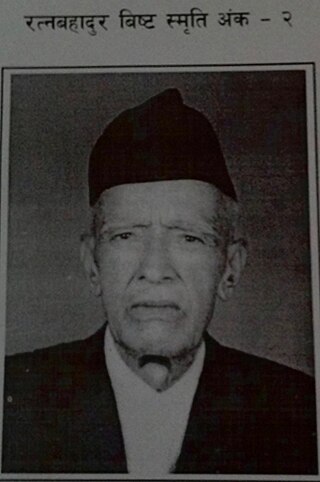
Ratna Bahadur Bista (1910–1990) was the fifth Chief Justice of Nepal. He was born in Dadeldhura to an aristocratic family that was given land grants in Sudurpashchim Province circa 1911 during a hunting trip by King George V of the United Kingdom and Chandra Shumsher Jang Bahadur Rana, the Prime Minister of the Rana Dynasty. He went on to become the 5th Chief Justice of Nepal, in office from 26 July 1970 to 6 August 1976. He was appointed by the then-king of Nepal, Mahendra. He was responsible for the Summary Procedure Act 1971. The Committee that he established recommended for the establishment of High Courts in different regions which resulted in the creation of a four tiered judicial structure with one additional tier in the middle- "the Regional Courts."

Zamindar Sir Lok Pratap Bista , was appointed by late King Mahendra of Nepal as the minister of Forest and Environment under the government led by Prime minister Surya Bahadur Thapa. The decree for forest conservation was released under his tenure that made logging illegal which was signed by King Mahendra of Nepal on October 5, 1970. He is responsible for setting up the Shuklaphanta National Park and Bardiya National Park as a Wildlife Reserve in 1969 under his tenure as Minister of Forests from 1968 to 1972. When the Democratic Government was dissolved by King Mahendra, he was nominated to the National Panchayat and made a Minister of Forests and Environment in 1968. He is the nephew of the late Chief Justice Ratna Bahadur Bista. During his tenure as the Minister of Forestry in FY 1970 the National GDP was estimated at $840 million in which Agriculture and forestry accounted for two- thirds of GDP. There was a 7.5% increase in GDP from FY 1969 since he took office.
Amik Sherchan is a Nepalese politician and current Governor of Lumbini Province of Nepal. He is former chairman of Janamorcha Nepal. He served as the Deputy Prime Minister & Health and Population Minister of Nepal in the interim government under Girija Prasad Koirala cabinet. He also served as the 2nd Governor of Gandaki Province of Nepal. He is active as a politician and prominent leader since 1967. He was elected as a member of the Pratinidhi Sabha and Member of 1st Constituent Assembly from Chitwan.

Rautahat 4 is one of four parliamentary constituencies of Rautahat District in Nepal. This constituency came into existence on the Constituency Delimitation Commission (CDC) report submitted on 31 August 2017.

Jhapa 1 is one of five parliamentary constituencies of Jhapa District in Nepal. This constituency came into existence on the Constituency Delimitation Commission (CDC) report submitted on 31 August 2017.

Morang 1 is one of six parliamentary constituencies of Morang District in Nepal. This constituency came into existence on the Constituency Delimitation Commission (CDC) report submitted on 31 August 2017.

Morang 5 is one of six parliamentary constituencies of Morang District in Nepal. This constituency came into existence on the Constituency Delimitation Commission (CDC) report submitted on 31 August 2017.

Matrika Prasad Koirala formed the first government of Nepal by a commoner after he was appointed as the prime minister by King Tribhuvan. The government was formed after the previous government under Mohan SJB Rana fell after Nepali Congress ministers resigned. King Tribhuvan made a royal proclamation on 16 November 1951 and invited Matrika Prasad Koirala from the Nepali Congress to form the government.

Matrika Prasad Koirala formed his second government in 1953 after his appointment by King Tribhuvan. The cabinet was expanded in February 1954 to include Nepal National Congress, Nepal Praja Parishad and Nepali Jan Congress.

Tanka Prasad Acharya formed a government on 27 January 1956 after being appointed as prime minister by King Mahendra. The cabinet was expanded in February 1957 to add more deputy ministers.

Bisheshwar Prasad Koirala formed the first elected government of Nepal on 27 May 1959. After the 1951 democratic movement, several transitional governments failed to hold the first general elections in the country until an interim government under Subarna SJB Rana held the 1959 general elections in two phases on 18 February and 3 April 1959. Nepali Congress gained a majority in the 1st House of Representatives of Nepal and Bishweshwar Prasad Koirala was elected as the parliamentary party leader of the Nepali Congress on 4 May 1959. On 16 May 1959, Koirala was invited by King Mahendra to form a government and the cabinet was formed on 27 May 1959 The cabinet was reshuffled just over a month later on 30 June 1959.
Parashuram Khapung is a Nepalese politician and current Governor of Koshi Province. He was appointed Governor, as per the Article 163 (2) of the Constitution of Nepal by the President Bidya Devi Bhandari on the recommendation of the Council of Ministers of the Government of Nepal on 11 November 2021. He is a former member of House of representatives.
Dhanraj Gurung is a Nepali politician belonging to Nepali Congress. Gurung is the current Minister for Law, Justice and Parlaimentary Affairs of Nepal. He is the current member of House of Representatives having been elected from Syangja 2.
Krishna Prasad Sitaula is a Nepali politician, belonging to the Nepali Congress. Krishna Sitaula is known for playing an important role during the comprehensive peace accord.
Kalpana Bista was the first female minister of education of Nepal in 1978.











